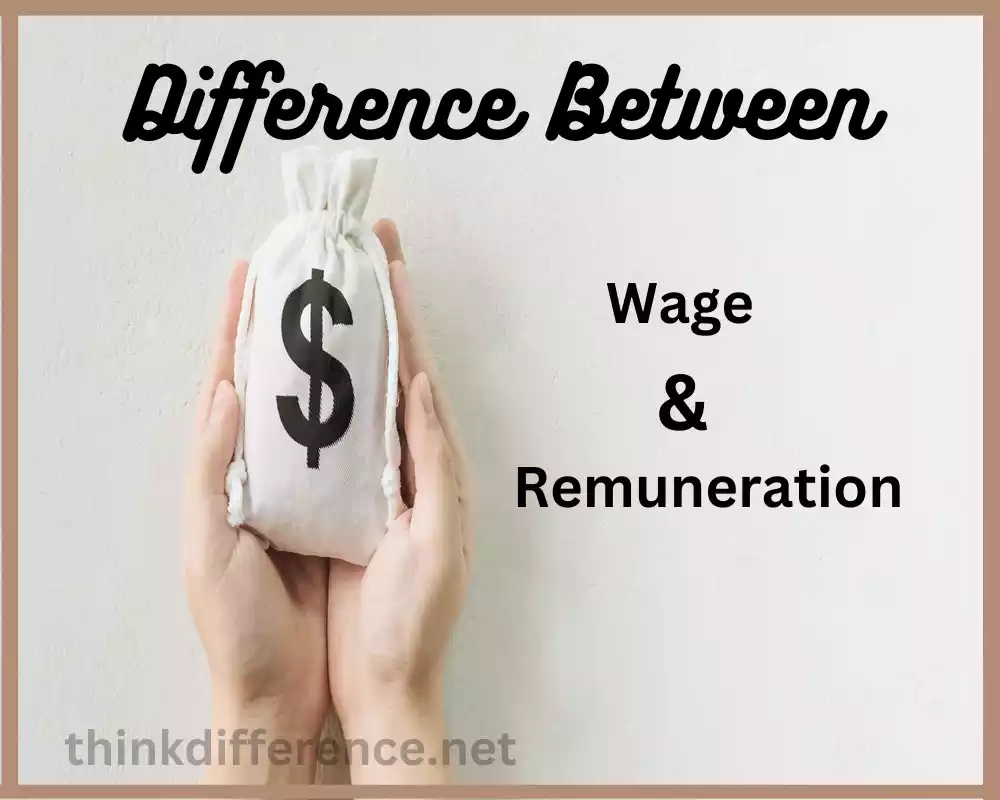Definition of Wage and Remuneration
Wage: Wages are compensation employers pay employees for labor or services provided, typically calculated using working hours completed or specific task completion rates. Wage calculations take account of many different variables such as payroll deduction rates.
Employee wages depend upon factors like job title, experience level, skill set, and industry norms. Minimum wage laws define minimum pay amounts while collective bargaining agreements may also have an influence.
Wages are the direct monetary compensation workers receive for their labor and can vary based on factors like hours worked and job duties.

Remuneration: Remuneration refers to all forms of compensation or rewards an individual receives for his/her services or work from their employers, both monetary and non-monetary rewards; including salary/wage as well as allowances/incentives/benefits that extend beyond basic wage structures.
Compensation plans often incorporate three components that vary based on industry and organization:
- Base Salary (Base Salary): An agreed-upon fixed sum that employees receive on an ongoing basis that varies based on factors like job level, market rates, and experience.
- Benefits and Allowances: Non-monetary compensations such as medical benefits, health insurance policies, retirement plans, and vacation packages may include housing allowances or transportation allowances as non-monetary perks for members.
- Perks: Non-monetary benefits or extra privileges that employees can be offered as non-monetary rewards or additional privileges to encourage performance and development, such as company cars, stock option plans, flexible working hours and opportunities for training and development programs, performance-based incentive schemes, profit sharing schemes or recognition programs.
Remuneration packages aim to motivate and attract employees by drawing them towards your organization, market competition, employee skills, performance, and industry standards. Remuneration structures vary for employees at different levels within an organization depending on factors like seniority, responsibility, performance, etc.
Remuneration refers to the total compensation package employees receive as employees are employed, which typically entails both financial rewards as well as various perks such as benefits and allowances beyond basic wages or salaries.
Importance of understanding the difference between Wage and Remuneration
Employees and employers should understand the differences between remuneration (payment) and wage. Here are some main points of this distinction that employees and employers need to bear in mind:
Employee Perspective:
- Clarity in Compensation: Understanding their compensation can help employees better appreciate its components, including any rewards being given to them. They may gain greater insight into what rewards exist within it as a whole and appreciate why their efforts have been recognized with paychecks or bonuses.
- Awareness of Total Rewards: Total rewards are crucially important to employees. Understanding that total compensation extends far beyond just salary and wages can enable an employee to accurately gauge the worth of their employment package – including benefits, allowances, and non-monetary incentives.
- Career Planning and Negotiation: Understanding the difference between career planning and negotiation will enable you to negotiate better terms during job interviews and performance reviews.
Employer Perspective:
- Compensation Strategy: By outlining wages and remuneration details, employers can develop compensation strategies that meet their organization’s goals, as well as retain and attract talented employees.
- Market Competence: By benchmarking compensation packages against industry benchmarks, employers can ensure they remain competitive when recruiting and retaining skilled employees.
- Employee Motivation: Employers can implement incentive and reward systems to motivate employees beyond base salaries by differentiating between wages and remuneration packages.
- Legal and Compliance Considerations: Clearly understanding the differences between wages and remuneration ensures compliance with minimum wage laws as well as other compensation regulations.
Legal and Regulatory Considerations:
- Minimum Wage: By understanding the distinctions between wages and remuneration, organizations can ensure they meet legal obligations to pay employees the minimum wage set forth by the government.
- Reporting and Taxation: Separating wages from remuneration allows organizations to accurately report employee earnings for tax reporting as well as for other financial obligations.
Understanding the differences between wage and remuneration will enable both employers and employees to make educated decisions regarding compensation, leading them both to create fair workplace conditions with mutually advantageous employment relations.
Wage
Wages refer to compensation paid out to employees by employers for services or work performed, usually hourly but also daily, weekly, or monthly.

Here are some key aspects of wages:
- Monetary Compensation: Wages are the most prevalent form of compensation and are distributed as regular paychecks or direct deposits.
- Calculation by Time: Wages can be calculated based on how many working hours an employee put in for any pay period, earning them an hourly rate corresponding to each hour worked during this timeframe.
- Minimum Wage Laws: Many jurisdictions have minimum hourly wage laws which set out the lowest legal hourly pay rate that an employer can legally offer their employees. Minimum wage laws exist to safeguard workers and ensure fair compensation is received.
- Overtime Pay: Employees in certain circumstances could qualify for overtime pay. It usually applies when employees work over and above their minimum weekly work requirement as defined by law.
- Wage Determination: Wage determination can depend upon many different elements, including the market demand for jobs, industry standards and employee qualifications and skillsets, collective bargaining agreements, or internal policies.
- Wage Disbursement: Employers typically distribute wages regularly – usually weekly, biweekly, or monthly depending on their payroll schedule – to employees as part of their payroll obligations. Payments may be subject to deductions such as taxes, social insurance contributions and any legally mandated withholdings that must be withheld from payments such as social insurance contributions and taxes withheld for social insurance contributions.
Wages play an essential part in employee compensation and should play an essential role in recruiting talent and keeping it. Wages meet the basic financial needs of employees while having a direct effect on job satisfaction and motivation. Employers must abide by legal regulations regarding minimum wages and fair payment methods when calculating and providing wages to employees.
Remuneration
Remuneration refers to any rewards an individual receives in return for his or her work or services, including financial and non-financial recompense provided as part of an employer’s employment package. It includes both tangible benefits such as salaries or commissions, as well as non-financial incentives like health plans.

Here are some key aspects of remuneration:
- Comprehensive Compensation Package: Comprehensive compensation comprises more than just salaries or basic wages.
- Money and Non-Monetary Benefits: Remuneration packages typically offer both financial and non-financial rewards to employees. Monetary elements might include base salary and bonuses; incentive payments and allowances might all come together with nonmonetary elements like benefits like company cars or gym memberships being available as rewards as well.
- Incentivization or Performance-Based Compensation: Employee compensation packages typically feature bonuses or incentives tied to performance – whether individual, team, or achievement of specific goals and targets.
- Benefits and Perquisites: Remuneration may include benefits like healthcare coverage, retirement accounts, paid time off benefits, and parental leave as employee perks; in addition, perquisites could include flexible work arrangements or stock option plans provided by their company as perks – or any special privileges or privileges given them as employee perks.
- Customization and Flexibility: Remuneration packages can be personalized to the employee and employer alike, adapting to meet each one’s specific needs and preferences. Compensation structures could differ based on job level, industry-standard practices, company policies, or market rates.
- Total Rewards Approach: To motivate and retain employees, compensation plans often take the approach of total rewards remuneration – taking into consideration both financial compensation and non-financial aspects as effective motivators and retention tools.
- Recommendation: Remuneration of employees depends on a variety of factors, including an organization’s compensation philosophy and market competitiveness, employee performance evaluation results, and industry standards. Reviews should take place regularly to make sure it remains appropriate with changing organizational needs and requirements.
Employees and employers should understand remuneration. Doing so helps employees evaluate the worth of their compensation package and make informed career choices. While employers should utilize an understanding of remuneration to create effective compensation strategies that attract talent while encouraging employee satisfaction and engagement while meeting all legal and regulatory obligations.
Differences between Wage and Remuneration
Here is describe the differences between wages and remuneration:
1. Scope and Purpose:
- Wage: Wages represent direct financial compensation an employee receives in return for his or her work or services rendered, which may range from daily, weekly, or monthly payment plans.
- Remuneration: An employee’s compensation package encompasses both financial and non-financial rewards. This may include both non-monetary bonuses as well as benefits, allowances, or perks that enhance his/her well-being and satisfaction in their position.
2. Components:
- Wages: Wages consist of an hourly or base salary paid out to employees based on hours worked, without additional benefits or perks being included.
- Remuneration: Remuneration is a comprehensive term covering numerous components. These can include benefits like health insurance, pension plans, paid leave, and nonwage monetary rewards such as stock options or company cars or flexible work schedules; in some instances, nonwage rewards could even include nonmonetary perks.
3. Determination Factors:
- Wages: Wages refer to all components of an employee’s earnings package; such as health insurance, pensions and paid leave benefits as well as nonwage monetary incentives such as company cars or stock options that come as nonwage rewards and flexible schedules.
- Remuneration: Remuneration decisions are determined based on various criteria including organization policies, employee performance, and contribution evaluation, benchmarking on market standards competitiveness, and industry requirements; these considerations combine for an in-depth appraisal of an employee’s value to the organization.
4. Focus on Monetary vs. Total Rewards:
- Wages: Wages are defined as any financial compensation an employee receives for performing labor; in essence, it represents a payment made as compensation for work completed.
- Remuneration: Remuneration refers to any rewards an employee receives in addition to their basic salary or wage, such as benefits, incentives, or perks. It takes into account both tangible rewards as well as intangible ones when discussing rewards packages received.
Employers and employees should both understand the differences between wage and remuneration in order to evaluate compensation packages that attract talent, keep staff happy and create engaging working environments.
Employees can use this knowledge to evaluate their compensation package and make more informed career choices while employers use this data to design more comprehensive compensation packages to keep talent engaged with work environments that inspire innovation and creativity.
Significance and Implications
Understanding the difference between remuneration and wage has profound ramifications and significance for employers and employees alike. Here are its primary effects:
- Employee Motivation and Satisfaction: By understanding both wages and remuneration in more depth, employees can have a deeper insight into their total compensation package and gain a clearer perspective of their job’s true worth beyond salary alone, leading them to feel greater job satisfaction and motivation at work.
- Talent Attraction and Retention: Employers that offer competitive compensation packages tend to attract and retain top talent more effectively than others. Employers can craft compensation strategies tailored to employee expectations as well as market standards by understanding larger components of remuneration.
- Fairness and Equity: Understanding the difference between wages and remuneration helps employees evaluate fair and equitable compensation structures, so they know whether their skills, experiences, and contributions are being adequately compensated for.
- Employee Engagement and Productivity: Remuneration components like benefits, incentives, and perks have an immediate and profound effect on employee engagement and productivity. Workers who feel valued beyond their basic wage tend to become more motivated, engaged employees that perform at higher levels overall.
- Negotiation Power: Employees with an increased understanding of the differences between wages and remuneration will be better equipped to negotiate compensation during job interviews, promotions or evaluations. They can advocate for competitive packages which combine financial compensation with non-monetary rewards.
- Compliance With Legal Requirements: Employers must distinguish between wages and remuneration to comply with minimum salary laws and other legal requirements, so as to guarantee employees at least receive at least the mandated minimum wage amount and comply with labor law regarding compensation practices. This ensures employees receive at least this minimum threshold wage amount as mandated.
- Organizational Reputation: Organizations looking to gain a strong employer brand will find greater success if their remuneration offerings are fair and attractive, reflecting an organization’s dedication to rewarding and appreciating its workforce, creating positive associations for its employer brand, and drawing in top talent.
- Financial Planning: Understanding the differences between wages and remuneration can assist employees with planning their finances more effectively. They can evaluate the value of their compensation including allowances, incentives, and benefits to make informed choices when saving, investing or budgeting their finances.
Knowledge of wage vs compensation has far-reaching ramifications on employee satisfaction, talent development, fairness, and legal compliance – not to mention financial planning decisions affecting both employees and employers alike. Acquiring this insight will assist both employees and employers alike, leading to improved workplace relationships, enhanced productivity, and an edge on the job market.
Conclusion
Wage and Remuneration are integral components of the modern work environment, impacting individuals, businesses, and society at large. A fair and equitable compensation system not only enhances employee satisfaction and productivity but also contributes to a thriving economy. As workplaces continue to evolve, so will the concepts of wage and remuneration, making it imperative for employers and employees to stay informed and proactive.



